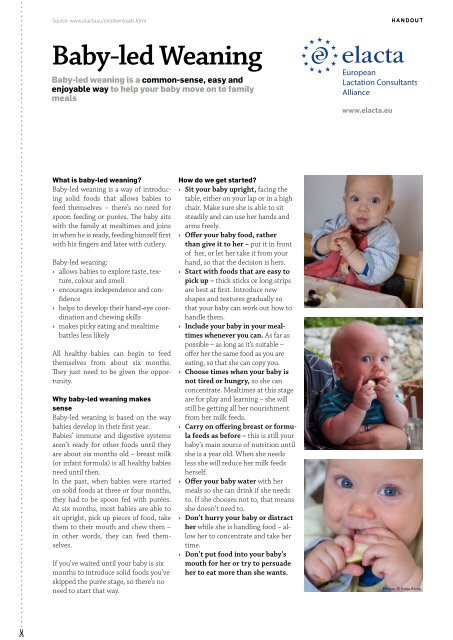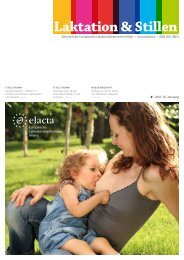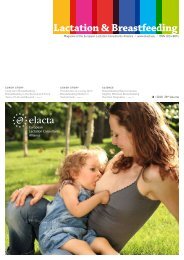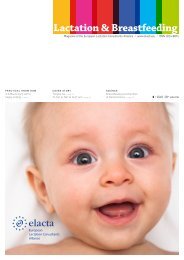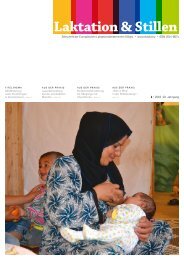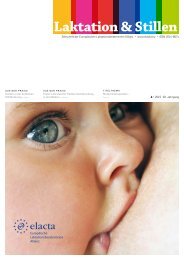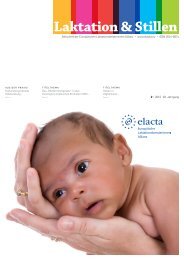Laktation_und_Stillen_2016-2 EN p1-8 web
You also want an ePaper? Increase the reach of your titles
YUMPU automatically turns print PDFs into web optimized ePapers that Google loves.
Source: www.elacta.eu/en/downloads.html<br />
HANDOUT<br />
Baby-led Weaning<br />
Baby-led weaning is a common-sense, easy and<br />
enjoyable way to help your baby move on to family<br />
meals<br />
www.elacta.eu<br />
What is baby-led weaning?<br />
Baby-led weaning is a way of introducing<br />
solid foods that allows babies to<br />
feed themselves – there’s no need for<br />
spoon feeding or purées. The baby sits<br />
with the family at mealtimes and joins<br />
in when he is ready, feeding himself first<br />
with his fingers and later with cutlery.<br />
Baby-led weaning:<br />
› allows babies to explore taste, texture,<br />
colour and smell<br />
› encourages independence and confidence<br />
› helps to develop their hand-eye coordination<br />
and chewing skills<br />
› makes picky eating and mealtime<br />
battles less likely<br />
All healthy babies can begin to feed<br />
themselves from about six months.<br />
They just need to be given the opportunity.<br />
Why baby-led weaning makes<br />
sense<br />
Baby-led weaning is based on the way<br />
babies develop in their first year.<br />
Babies’ immune and digestive systems<br />
aren’t ready for other foods until they<br />
are about six months old – breast milk<br />
(or infant formula) is all healthy babies<br />
need until then.<br />
In the past, when babies were started<br />
on solid foods at three or four months,<br />
they had to be spoon fed with purées.<br />
At six months, most babies are able to<br />
sit upright, pick up pieces of food, take<br />
them to their mouth and chew them –<br />
in other words, they can feed themselves.<br />
If you’ve waited until your baby is six<br />
months to introduce solid foods you’ve<br />
skipped the purée stage, so there’s no<br />
need to start that way.<br />
How do we get started?<br />
› Sit your baby upright, facing the<br />
table, either on your lap or in a high<br />
chair. Make sure she is able to sit<br />
steadily and can use her hands and<br />
arms freely.<br />
› Offer your baby food, rather<br />
than give it to her – put it in front<br />
of her, or let her take it from your<br />
hand, so that the decision is hers.<br />
› Start with foods that are easy to<br />
pick up – thick sticks or long strips<br />
are best at first. Introduce new<br />
shapes and textures gradually so<br />
that your baby can work out how to<br />
handle them.<br />
› Include your baby in your mealtimes<br />
whenever you can. As far as<br />
possible – as long as it’s suitable –<br />
offer her the same food as you are<br />
eating, so that she can copy you.<br />
› Choose times when your baby is<br />
not tired or hungry, so she can<br />
concentrate. Mealtimes at this stage<br />
are for play and learning – she will<br />
still be getting all her nourishment<br />
from her milk feeds.<br />
› Carry on offering breast or formula<br />
feeds as before – this is still your<br />
baby’s main source of nutrition until<br />
she is a year old. When she needs<br />
less she will reduce her milk feeds<br />
herself.<br />
› Offer your baby water with her<br />
meals so she can drink if she needs<br />
to. If she chooses not to, that means<br />
she doesn’t need to.<br />
› Don’t hurry your baby or distract<br />
her while she is handling food – allow<br />
her to concentrate and take her<br />
time.<br />
› Don’t put food into your baby’s<br />
mouth for her or try to persuade<br />
her to eat more than she wants.<br />
Photos: © Katja König


